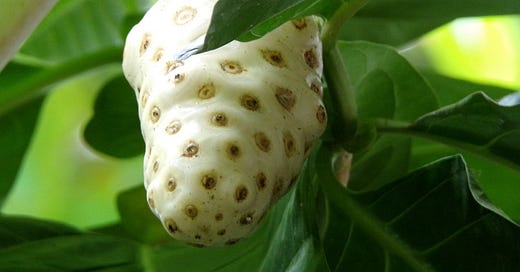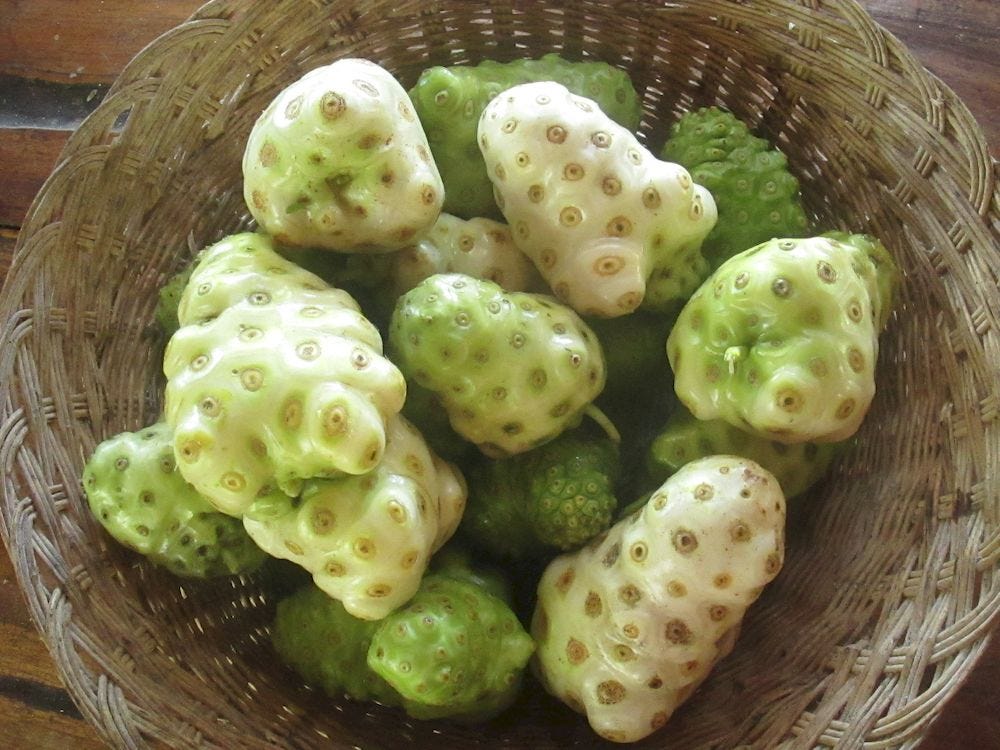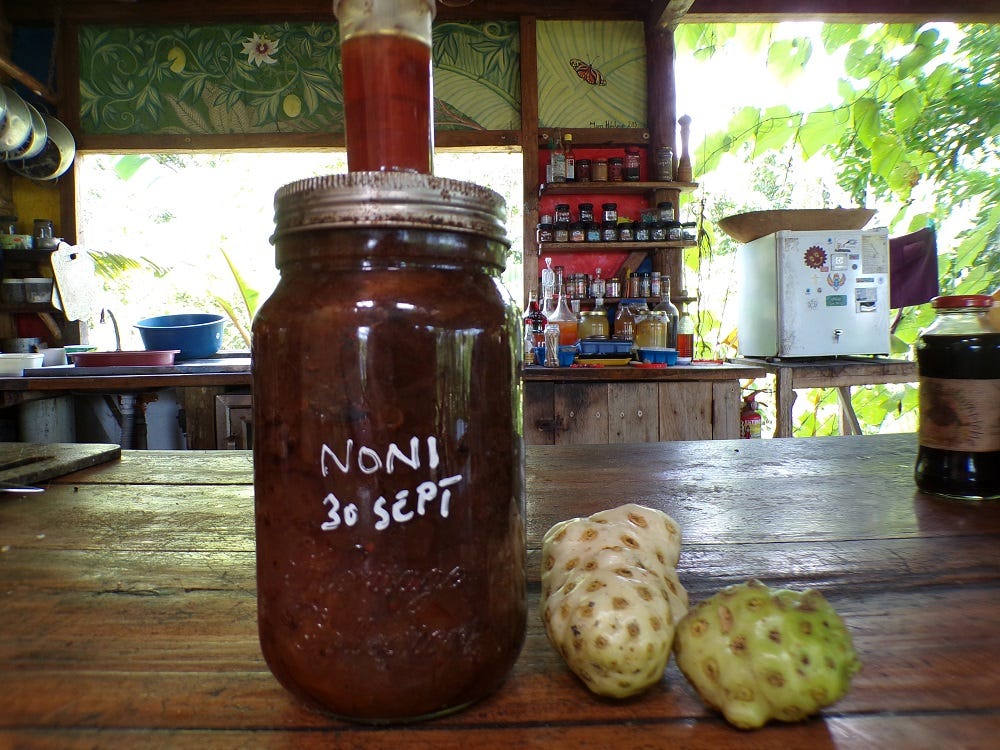The first time I ever encountered a noni fruit was on Magnetic Island, located just off Townsville, Queensland, in Australia twenty-something years ago. My friend Tatjana, who lived on the island at the time, showed me the weird-looking fruit that was growing on a tree outside a pub in Arcadia Bay as we were walking one afternoon. She told me about all its magical health benefits and healing properties. I retained the information, and the beautiful memory, but rarely saw the fruit again until I moved to Mompiche. These days, I have noni trees in the garden that I harvest and then use the fruit to make vinegar.
Noni (Morinda Citrifolia) is a fruit-bearing tree closely related to the coffee family, Rubiaceae. A traditional plant medicine in Hawaiian and Samoan cultures, noni is used to treat colds, flu, diabetes, and high blood pressure, as well as for depression and anxiety. It’s also known as an antioxidant and there are claims it can boost the immune system and has analgesic and anti-inflammatory properties. Some scientific research has been done to prove some of these health benefits, but not all of them. I use my own aged and organic noni vinegar to treat infrequent bouts of indigestion and also to prevent leg cramps at night. The ugly lumpish fruit is high in potassium, magnesium, zinc, and vitamins B and C. However, the almost translucent ripened noni smells distinctly like last week’s unwashed football socks that were left in the corner.
Once I’ve picked all the ripening fruit from my own trees, I head down the main road just past the bridge and pilfer a little more ripe fruit from a whole bunch of noni trees planted along the fence line of a private property. I have no idea who owns that land. I just know they have buckets of noni fruits falling off their trees every six months or so and I hate to see them go to waste. It only takes twenty minutes to fill several bags and then heave as much noni as I can carry back to my own kitchen to be washed and dried, and processed into vinegar. The homegrown fruit is fermented and processed separately from the pilfered fruit so I can tell the difference between the two.
Making noni vinegar is actually an incredibly simple process. Once the fruit is dry, I fill clean, sterilized jars or buckets with the ripe fruits. They’re kind of mushy at that stage, so I can squish a few extra fruit into each jar if I need to. There’s nothing else in the jar, just fruit. I add a weight to the top, then fit the lid with a fermentation valve, and let it sit in a cool dark cupboard for three months. If I use a bucket, I use lots of fine fabric and paper filters to keep the bugs out. After it’s been sitting around for at least ninety days, I strain out all the solids that are left and run the pungent black liquid through a fine filter. At this point, even though it’s now liquid, it’s still not yet ready to use.
The filtered black liquid goes into large bottles, once again with fermentation valves, and is left for about twelve months. It’s checked every so often to make sure there’s no mold forming on top. It’s normal to see some white fermentation yeast, but the smallest speck of black mold harks the end of the whole noni vinegar project and you have to ditch the whole lot and start over from the beginning. There is no way to save putrid moldy noni. This happened once a few years ago and, after disposing of the entire reeking mess, I was compelled to go and pilfer more noni fruits from the side of the road since my own trees didn’t have any fruit at the time. Assuming no black mold appears, and all the sediment is at the bottom of the jar, undisturbed, the vinegar can be bottled into smaller bottles. For myself, I use recycled glass balsamic vinegar bottles because they come with a little portion control doobilacky to make sure you don’t accidentally pour out too much vinegar. Then, these smaller bottles go in the back of the cupboard and are forgotten for another year or so while it ages. After that, the noni vinegar is ready to rock and roll.
After a couple of years of aging into a rich aromatic liquid, noni vinegar looks and tastes like some kind of weird black gothic wine. It no longer has an aroma like someone left a chunk of blue cheese under the fridge for six months. It’s actually not terrible to drink as an elixir for various ailments—there are way worse-tasting natural remedies! I keep a small medicine cup on top of the lid so I can pour out an exact portion whenever I need it. There’s no telling when a four a.m. killer cramp in my calf or inner thigh (the absolute worst place to get a night cramp) will have me leaping out of bed to slam a shot or two of noni vinegar and gulp down a liter of water. After an excruciating charley horse like that, I take noni shots before bed for a week or so to keep the night cramps at bay.
The process of growing and picking a fruit that eventually becomes a natural medicine is incredibly satisfying. From start to finish, during each step of the process, I know exactly what’s in each bottle, where each fruit came from, and how long it’s been aged, and I can be sure all the fruit is organic. I also know this medicine works. I have no idea how anyone ever thought an ugly fruit that looks like a ready-to-burst pimple on steroids and smells like grandpa’s farts would be a superfood and natural medicine, but I’m really glad they did! Noni vinegar truly is the elixir of life!









